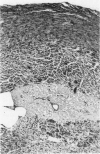Abstract
The mechanisms of bromobenzene toxicity in extrahepatic tissues of mice were studied. Kidney, lung, heart and brain were examined. As observed in this as well as in a previous report for the liver, bromobenzene intoxication caused a progressive decrease in the glutathione content of all the tissues examined. Cellular damage (as assessed by both biochemical determinations and histologic observations) appeared after 6 hours in the case of the kidney and the heart and after 15 hours in the case of the lung. Lipid peroxidation (as assessed by the tissue content of malonic dialdehyde, a parameter correlating with both the diene conjugation absorption and the amount of carbonyl functions in cellular phospholipids) was found to occur at the same times at which cellular damage was observed or even before. As in the case of bromobenzene-induced liver injury, when the individual values for cell damage obtained at 15-20 hours were plotted against the corresponding glutathione contents, a severe cellular damage was generally observed when the glutathione levels reached a threshold value (3.0-0.5 nmol/mg protein). Such a glutathione threshold was also observed for the onset of lipid peroxidation. Glutathione depletion and lipid peroxidation are therefore general phenomena occurring not only in the liver but in all the tissues as a consequence of bromobenzene poisoning. The possibility that lipid peroxidation is the cause of bromobenzene-induced damage to liver and extrahepatic tissues is discussed.
Full text
PDF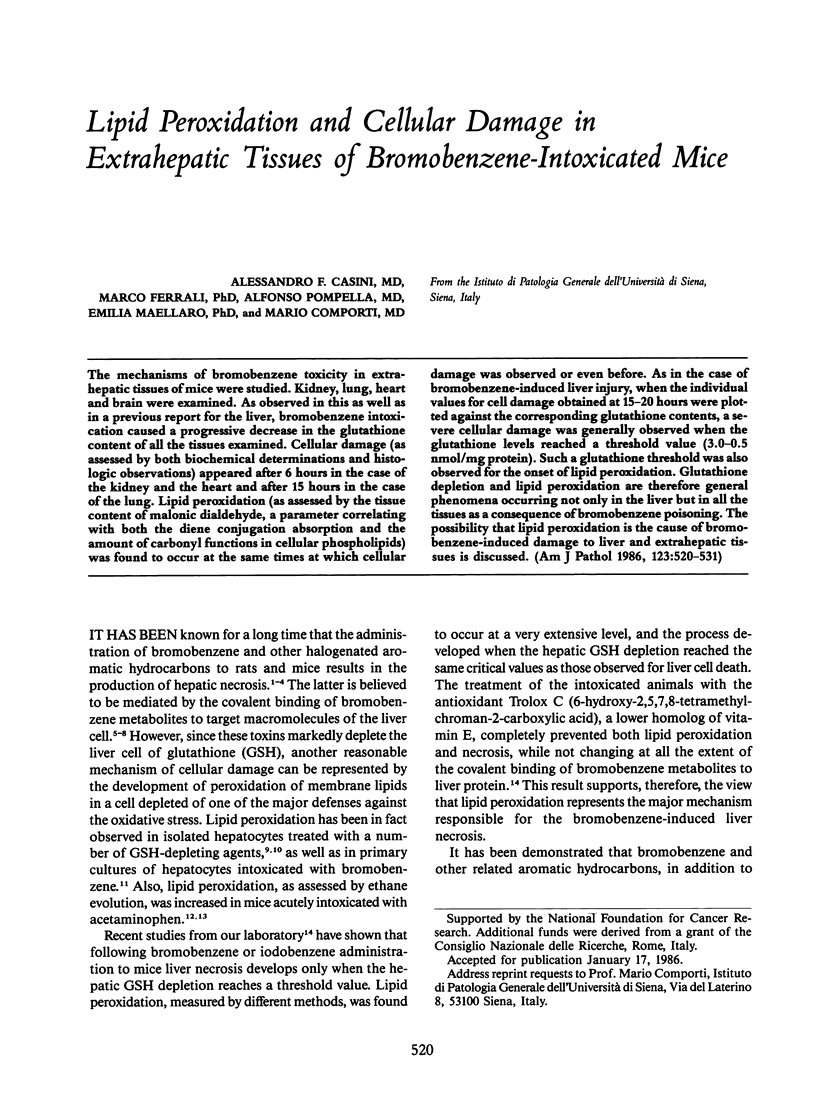
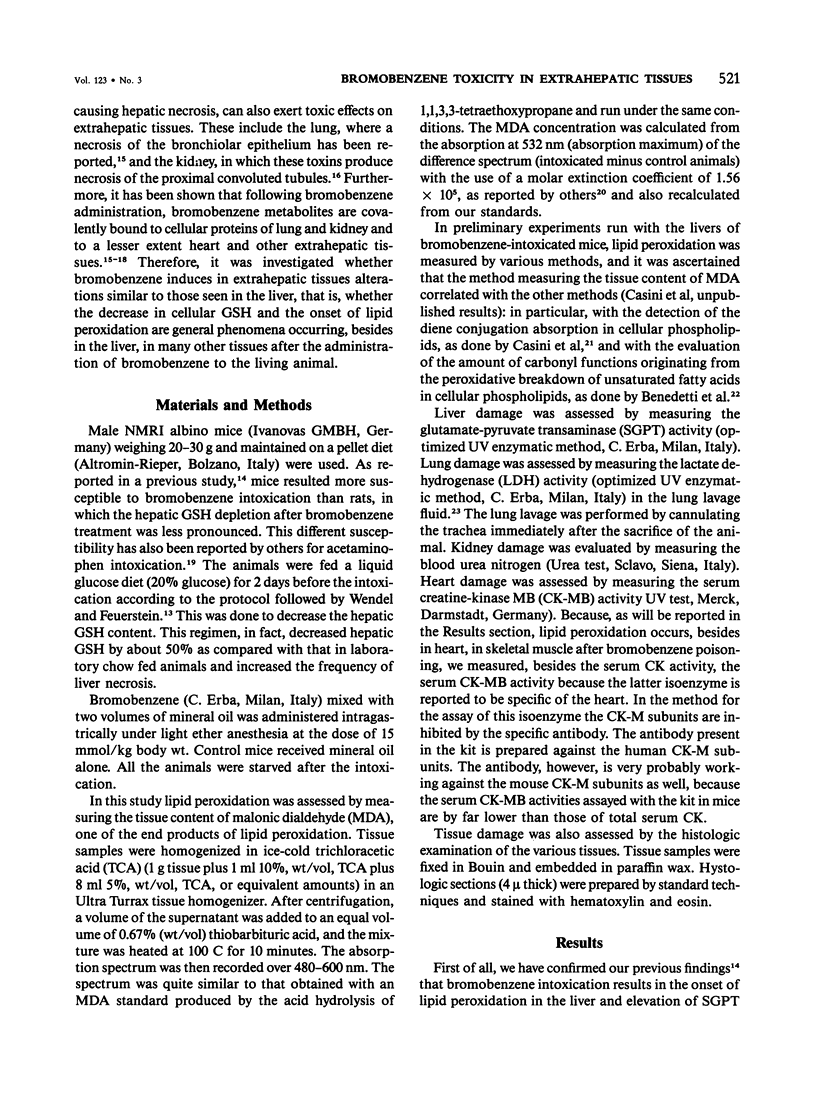
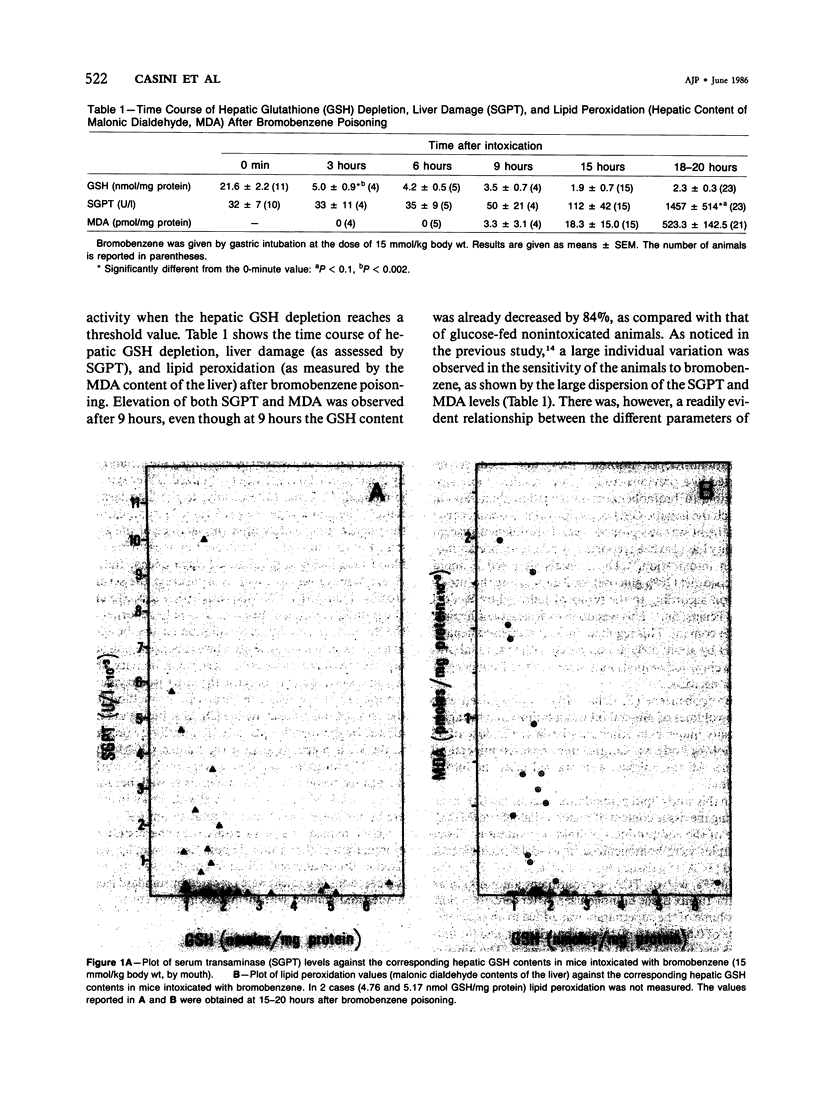
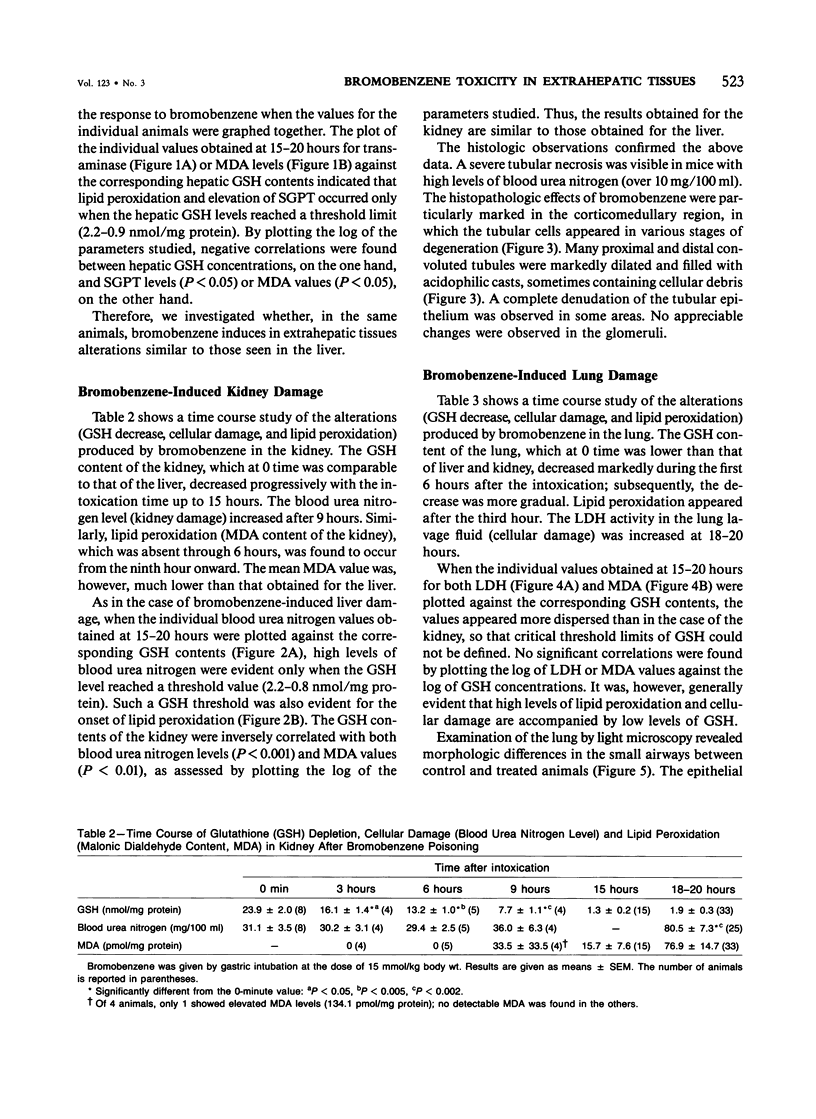
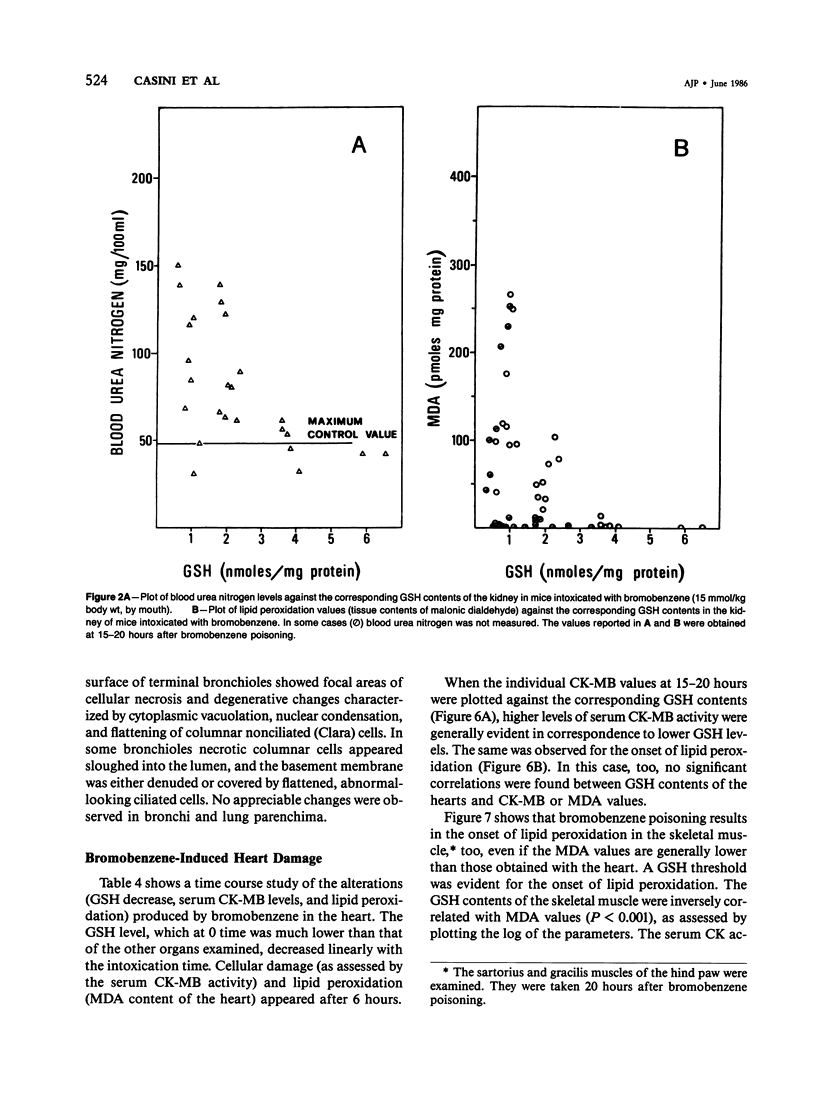
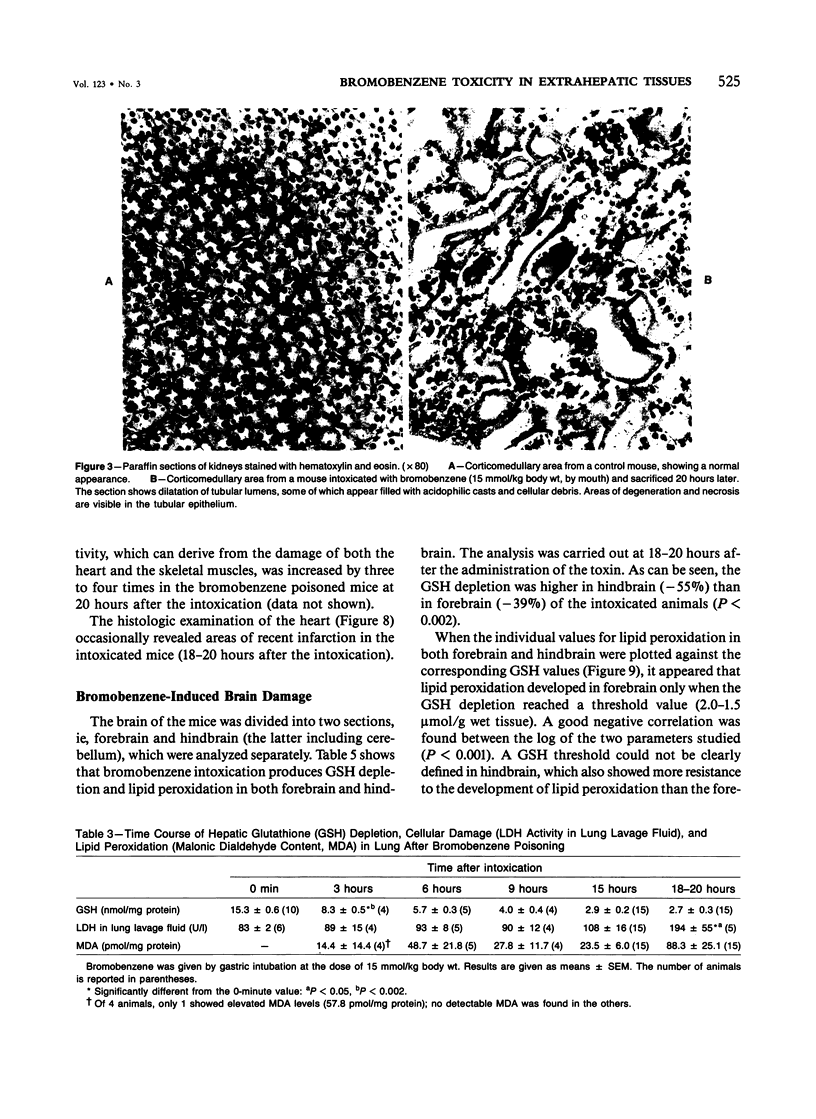
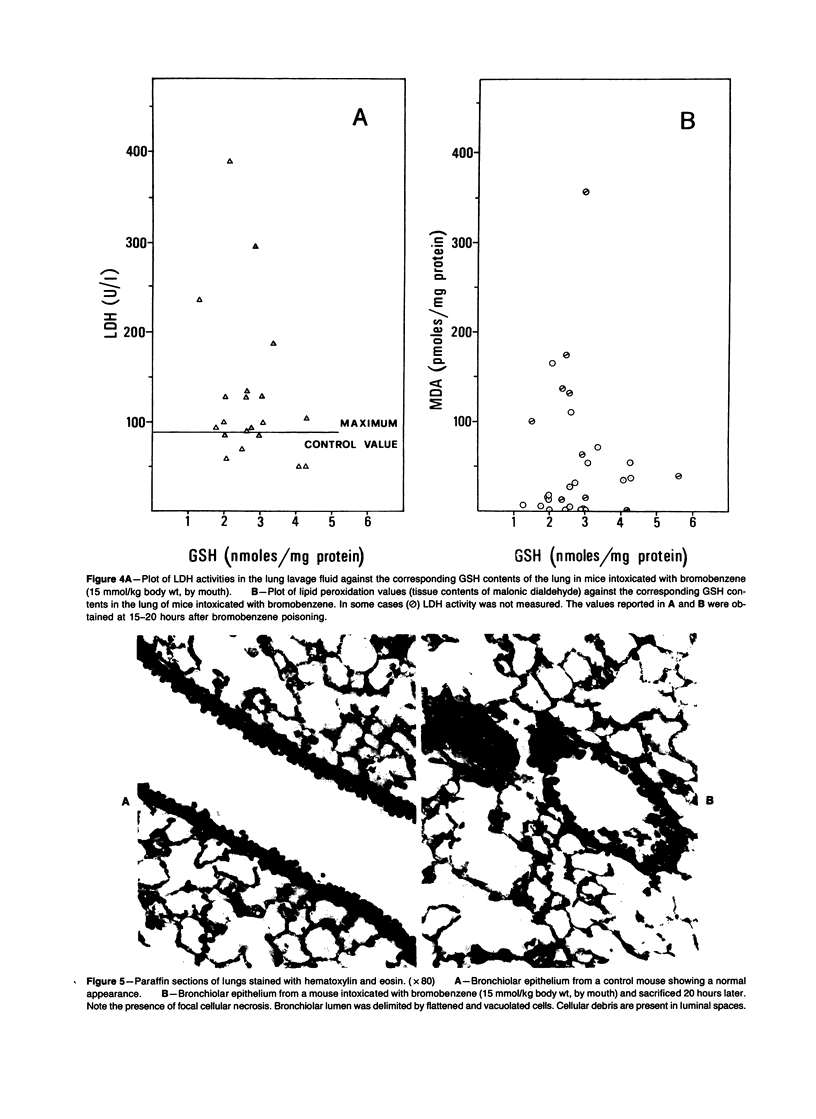
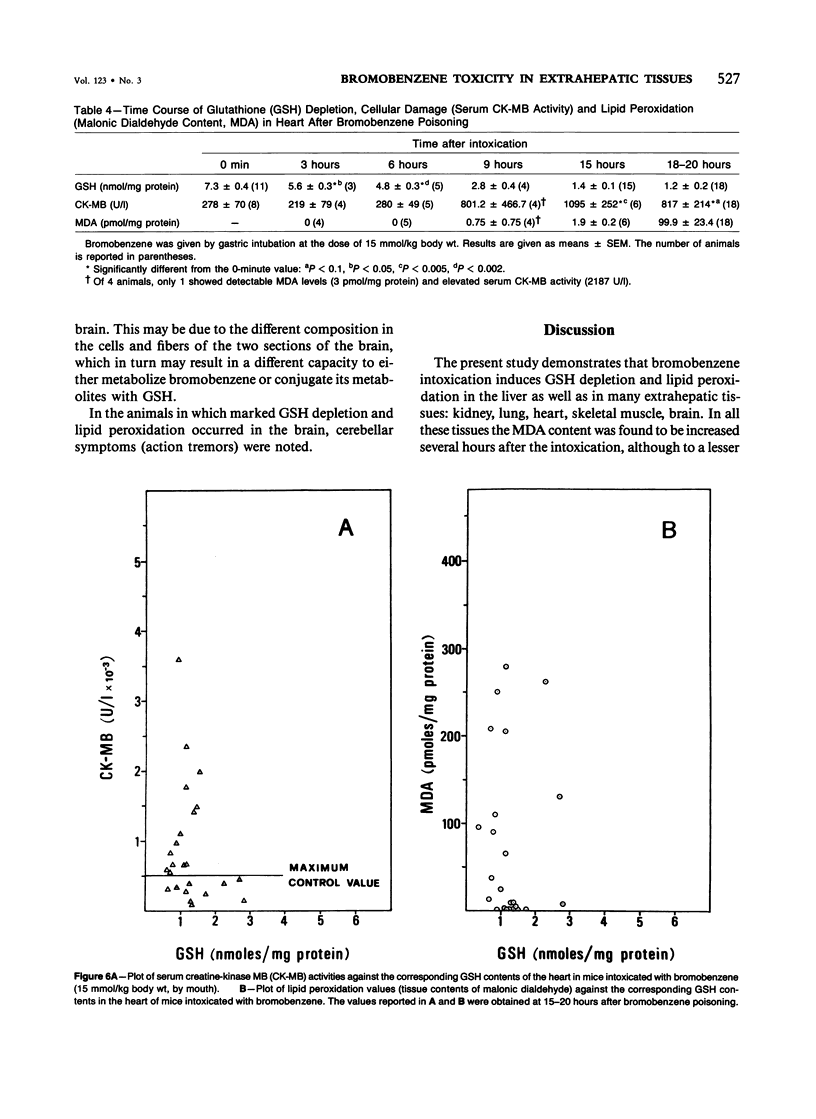
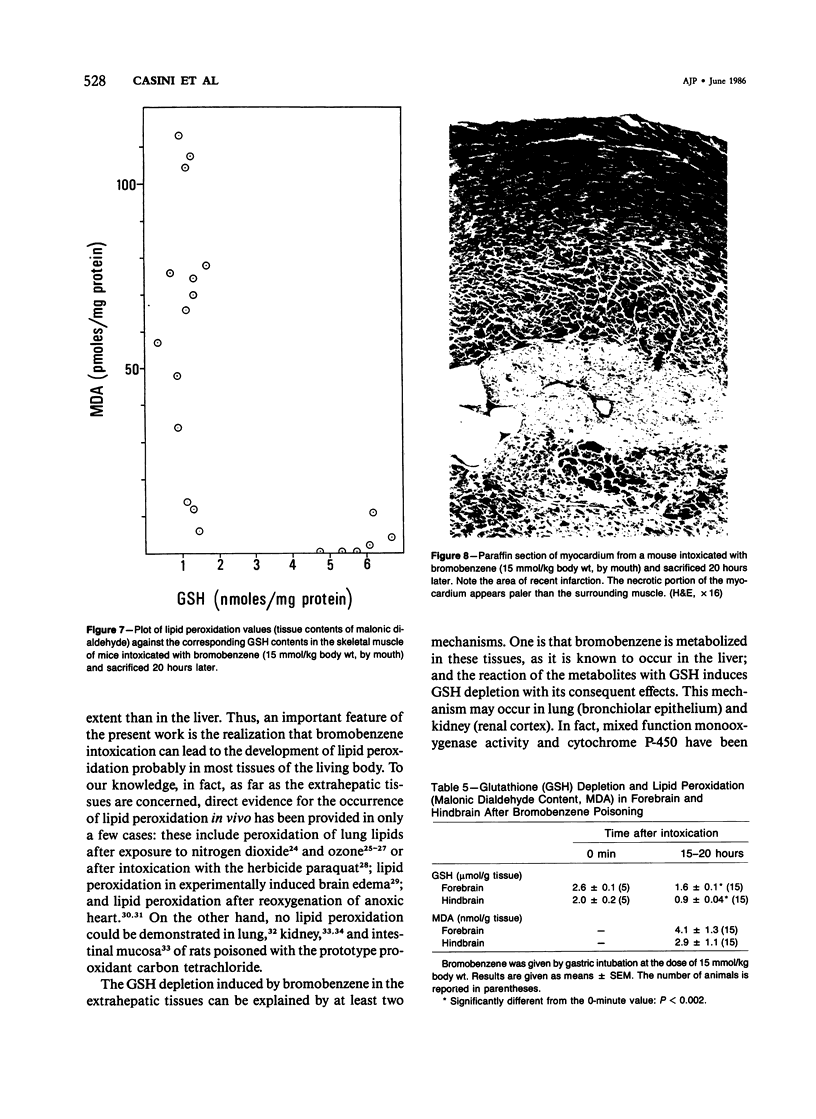
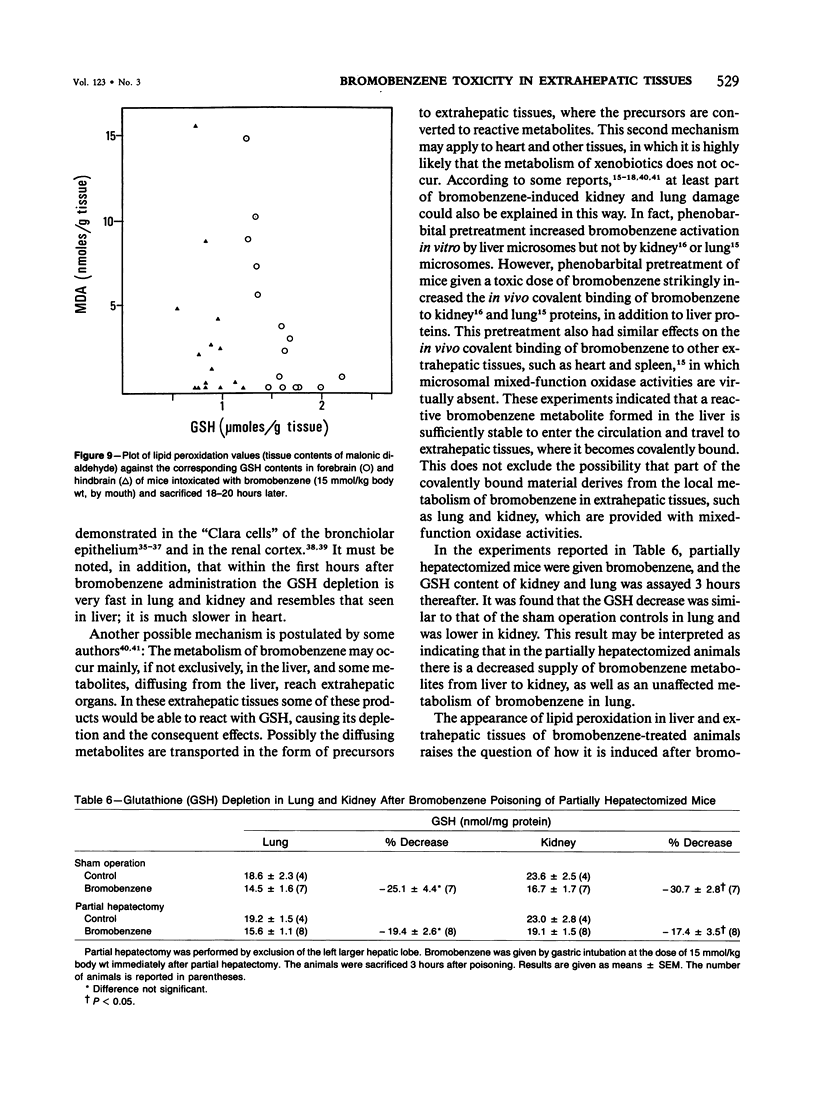
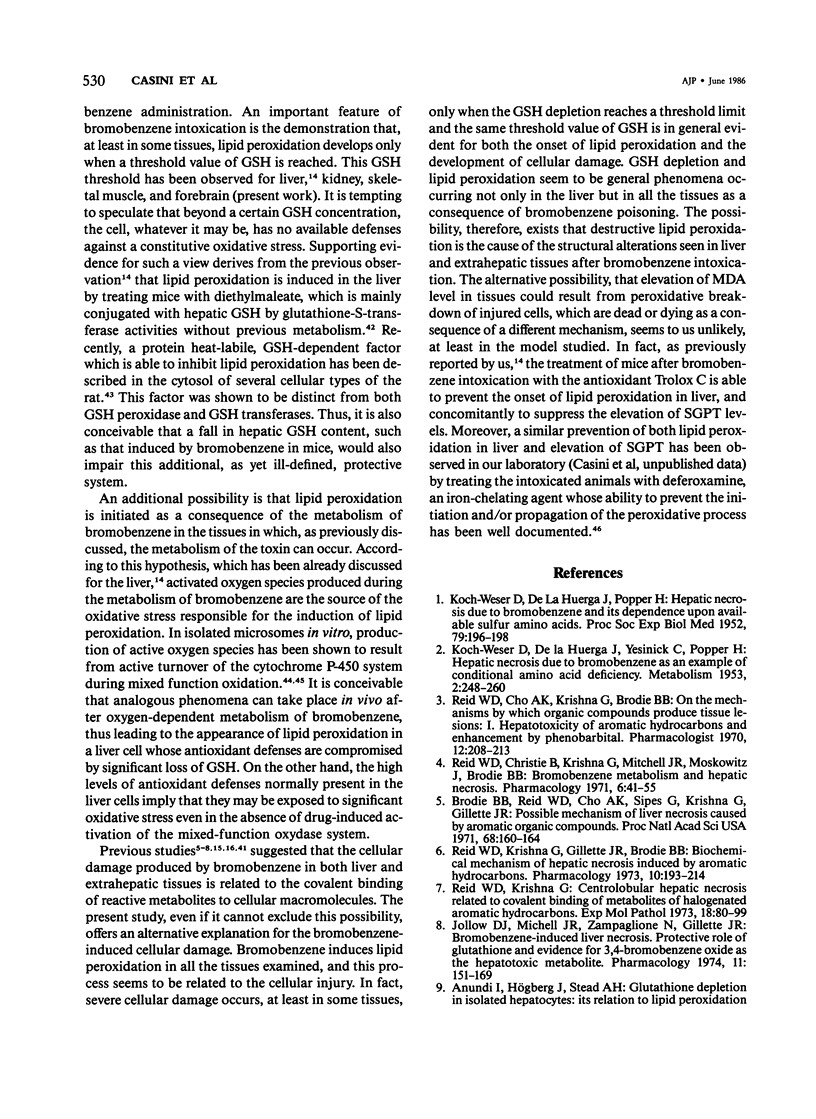
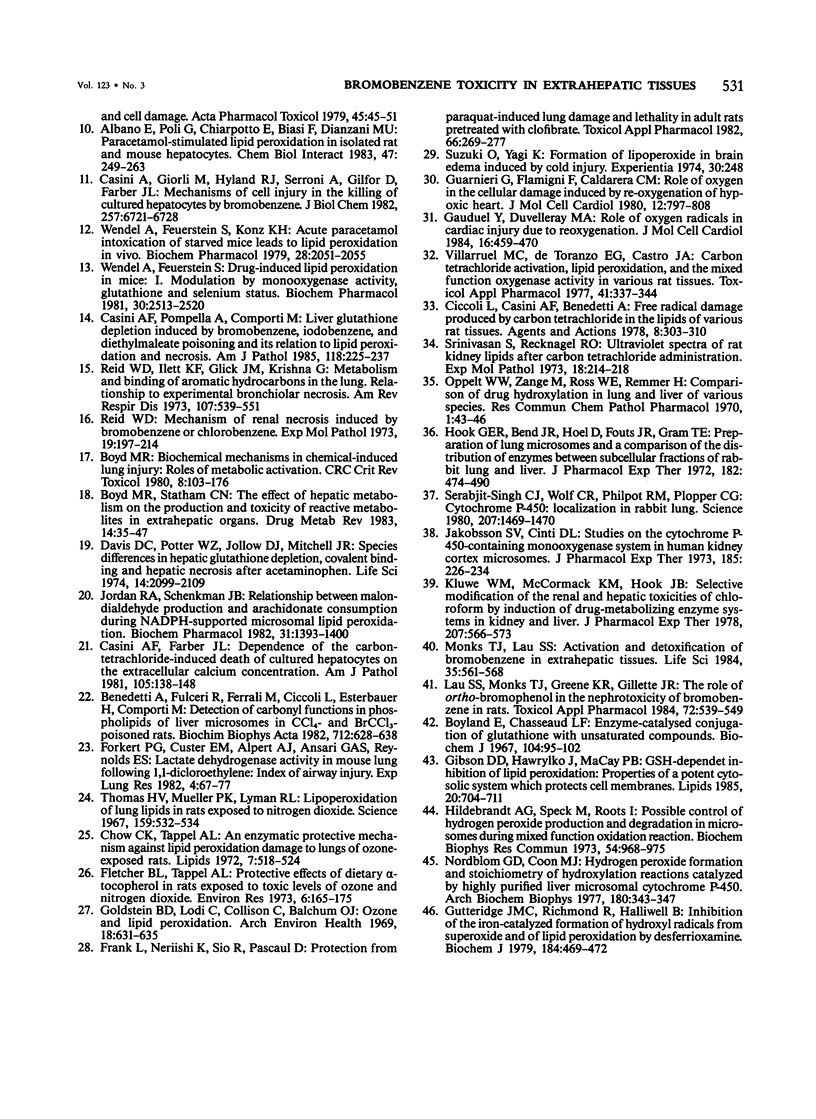
Images in this article
Selected References
These references are in PubMed. This may not be the complete list of references from this article.
- Albano E., Poli G., Chiarpotto E., Biasi F., Dianzani M. U. Paracetamol-stimulated lipid peroxidation in isolated rat and mouse hepatocytes. Chem Biol Interact. 1983 Dec;47(3):249–263. doi: 10.1016/0009-2797(83)90161-8. [DOI] [PubMed] [Google Scholar]
- Anundi I., Högberg J., Stead A. H. Glutathione depletion in isolated hepatocytes: its relation to lipid peroxidation and cell damage. Acta Pharmacol Toxicol (Copenh) 1979 Jul;45(1):45–51. doi: 10.1111/j.1600-0773.1979.tb02359.x. [DOI] [PubMed] [Google Scholar]
- Benedetti A., Fulceri R., Ferrali M., Ciccoli L., Esterbauer H., Comporti M. Detection of carbonyl functions in phospholipids of liver microsomes in CCl4- and BrCCl3-poisoned rats. Biochim Biophys Acta. 1982 Sep 14;712(3):628–638. doi: 10.1016/0005-2760(82)90292-2. [DOI] [PubMed] [Google Scholar]
- Boyd M. R. Biochemical mechanisms in chemical-induced lung injury: roles of metabolic activation. Crit Rev Toxicol. 1980 Aug;7(2):103–176. doi: 10.3109/10408448009037487. [DOI] [PubMed] [Google Scholar]
- Boyd M. R., Statham C. N. The effect of hepatic metabolism on the production and toxicity of reactive metabolites in extrahepatic organs. Drug Metab Rev. 1983;14(1):35–47. doi: 10.3109/03602538308991379. [DOI] [PubMed] [Google Scholar]
- Boyland E., Chasseaud L. F. Enzyme-catalysed conjugations of glutathione with unsaturated compounds. Biochem J. 1967 Jul;104(1):95–102. doi: 10.1042/bj1040095. [DOI] [PMC free article] [PubMed] [Google Scholar]
- Brodie B. B., Reid W. D., Cho A. K., Sipes G., Krishna G., Gillette J. R. Possible mechanism of liver necrosis caused by aromatic organic compounds. Proc Natl Acad Sci U S A. 1971 Jan;68(1):160–164. doi: 10.1073/pnas.68.1.160. [DOI] [PMC free article] [PubMed] [Google Scholar]
- Casini A. F., Farber J. L. Dependence of the carbon-tetrachloride--induced death of cultured hepatocytes on the extracellular calcium concentration. Am J Pathol. 1981 Nov;105(2):138–148. [PMC free article] [PubMed] [Google Scholar]
- Casini A. F., Pompella A., Comporti M. Liver glutathione depletion induced by bromobenzene, iodobenzene, and diethylmaleate poisoning and its relation to lipid peroxidation and necrosis. Am J Pathol. 1985 Feb;118(2):225–237. [PMC free article] [PubMed] [Google Scholar]
- Casini A., Giorli M., Hyland R. J., Serroni A., Gilfor D., Farber J. L. Mechanisms of cell injury in the killing of cultured hepatocytes by bromobenzene. J Biol Chem. 1982 Jun 25;257(12):6721–6728. [PubMed] [Google Scholar]
- Chow C. K., Tappel A. L. An enzymatic protective mechanism against lipid peroxidation damage to lungs of ozone-exposed rats. Lipids. 1972 Aug;7(8):518–524. doi: 10.1007/BF02533017. [DOI] [PubMed] [Google Scholar]
- Ciccoli L., Casini A. F., Benedetti A. Free radical damage produced by carbon tetrachloride in the lipids of various rat tissues. Agents Actions. 1978 Apr;8(3):303–310. doi: 10.1007/BF01966620. [DOI] [PubMed] [Google Scholar]
- Davis D. C., Potter W. Z., Jollow D. J., Mitchell J. R. Species differences in hepatic glutathione depletion, covalent binding and hepatic necrosis after acetaminophen. Life Sci. 1974 Jun 1;14(11):2099–2109. doi: 10.1016/0024-3205(74)90092-7. [DOI] [PubMed] [Google Scholar]
- Fletcher B. L., Tappel A. L. Protective effects of dietary -tocopherol in rats exposed to toxic levels of ozone and nitrogen dioxide. Environ Res. 1973 Jun;6(2):165–175. doi: 10.1016/0013-9351(73)90030-3. [DOI] [PubMed] [Google Scholar]
- Forkert P. G., Custer E. M., Alpert A. J., Ansari G. A., Reynolds E. S. Lactate dehydrogenase activity in mouse lung following 1,1-dichloroethylene: index of airway injury. Exp Lung Res. 1982 Dec;4(1):67–77. doi: 10.3109/01902148209039250. [DOI] [PubMed] [Google Scholar]
- Frank L., Neriishi K., Sio R., Pascual D. Protection from paraquat-induced lung damage and lethality in adult rats pretreated with clofibrate. Toxicol Appl Pharmacol. 1982 Nov;66(2):269–277. doi: 10.1016/0041-008x(82)90292-7. [DOI] [PubMed] [Google Scholar]
- Gauduel Y., Duvelleroy M. A. Role of oxygen radicals in cardiac injury due to reoxygenation. J Mol Cell Cardiol. 1984 May;16(5):459–470. doi: 10.1016/s0022-2828(84)80617-3. [DOI] [PubMed] [Google Scholar]
- Gibson D. D., Hawrylko J., McCay P. B. GSH-dependent inhibition of lipid peroxidation: properties of a potent cytosolic system which protects cell membranes. Lipids. 1985 Oct;20(10):704–711. doi: 10.1007/BF02534391. [DOI] [PubMed] [Google Scholar]
- Goldstein B. D., Lodi C., Collinson C., Balchum O. J. Ozone and lipid peroxidation. Arch Environ Health. 1969 Apr;18(4):631–635. doi: 10.1080/00039896.1969.10665464. [DOI] [PubMed] [Google Scholar]
- Guarnieri C., Flamigni F., Caldarera C. M. Role of oxygen in the cellular damage induced by re-oxygenation of hypoxic heart. J Mol Cell Cardiol. 1980 Aug;12(8):797–808. doi: 10.1016/0022-2828(80)90081-4. [DOI] [PubMed] [Google Scholar]
- Gutteridge J. M., Richmond R., Halliwell B. Inhibition of the iron-catalysed formation of hydroxyl radicals from superoxide and of lipid peroxidation by desferrioxamine. Biochem J. 1979 Nov 15;184(2):469–472. doi: 10.1042/bj1840469. [DOI] [PMC free article] [PubMed] [Google Scholar]
- Hildebrandt A. G., Speck M., Roots I. Possible control of hydrogen peroxide production and degradation in microsomes during mixed function oxidation reaction. Biochem Biophys Res Commun. 1973 Oct 1;54(3):968–975. doi: 10.1016/0006-291x(73)90789-4. [DOI] [PubMed] [Google Scholar]
- Hook G. E., Bend J. R., Hoel D., Fouts J. R., Gram T. E. Preparation of lung microsomes and a comparison of the distribution of enzymes between subcellular fractions of rabbit lung and liver. J Pharmacol Exp Ther. 1972 Sep;182(3):474–490. [PubMed] [Google Scholar]
- Jakobsson S. V., Cintig D. L. Studies on the cytochrome P-450-containing mono-oxygenase system in human kidney cortex microsomes. J Pharmacol Exp Ther. 1973 May;185(2):226–234. [PubMed] [Google Scholar]
- Jollow D. J., Mitchell J. R., Zampaglione N., Gillette J. R. Bromobenzene-induced liver necrosis. Protective role of glutathione and evidence for 3,4-bromobenzene oxide as the hepatotoxic metabolite. Pharmacology. 1974;11(3):151–169. doi: 10.1159/000136485. [DOI] [PubMed] [Google Scholar]
- Jordan R. A., Schenkman J. B. Relationship between malondialdehyde production and arachidonate consumption during NADPH-supported microsomal lipid peroxidation. Biochem Pharmacol. 1982 Apr 1;31(7):1393–1400. doi: 10.1016/0006-2952(82)90034-x. [DOI] [PubMed] [Google Scholar]
- KOCH WESER D., DE LA HUERGA J., POPPER H. Hepatic necrosis due to bromobenzene and its dependence upon available sulfur amino acids. Proc Soc Exp Biol Med. 1952 Jan;79(1):196–198. doi: 10.3181/00379727-79-19320. [DOI] [PubMed] [Google Scholar]
- KOCH-WESER D., DE LA HUERGA J., YESINICK C., POPPER H. Heptatic necrosis due to bromobenzene as an example of conditioned amino acid deficiency. Metabolism. 1953 May;2(3):248–260. [PubMed] [Google Scholar]
- Kluwe W. M., McCormack K. M., Hook J. B. Selective modification of the renal and the hepatic toxicities of chloroform by induction of drug-metabolizing enzyme systems in kidney and liver. J Pharmacol Exp Ther. 1978 Nov;207(2):566–573. [PubMed] [Google Scholar]
- Lau S. S., Monks T. J., Greene K. E., Gillette J. R. The role of ortho-bromophenol in the nephrotoxicity of bromobenzene in rats. Toxicol Appl Pharmacol. 1984 Mar 15;72(3):539–549. doi: 10.1016/0041-008x(84)90131-5. [DOI] [PubMed] [Google Scholar]
- Monks T. J., Lau S. S. Activation and detoxification of bromobenzene in extrahepatic tissues. Life Sci. 1984 Jul 30;35(5):561–568. doi: 10.1016/0024-3205(84)90250-9. [DOI] [PubMed] [Google Scholar]
- Nordblom G. D., Coon M. J. Hydrogen peroxide formation and stoichiometry of hydroxylation reactions catalyzed by highly purified liver microsomal cytochrome P-450. Arch Biochem Biophys. 1977 Apr 30;180(2):343–347. doi: 10.1016/0003-9861(77)90047-9. [DOI] [PubMed] [Google Scholar]
- Oppelt W. W., Zange M., Ross W. E., Remmer H. Comparison of microsomal drug hydroxylation in lung and liver of various species. Res Commun Chem Pathol Pharmacol. 1970 Jan;1(1):43–56. [PubMed] [Google Scholar]
- Reid W. D., Christie B., Krishna G., Mitchell J. R., Moskowitz J., Brodie B. B. Bromobenzene metabolism and hepatic necrosis. Pharmacology. 1971;6(1):41–55. doi: 10.1159/000136226. [DOI] [PubMed] [Google Scholar]
- Reid W. D., Ilett K. F., Glick J. M., Krishna G. Metabolism and binding of aromatic hydrocarbons in the lung. Relationship to experimental bronchiolar necrosis. Am Rev Respir Dis. 1973 Apr;107(4):539–551. doi: 10.1164/arrd.1973.107.4.539. [DOI] [PubMed] [Google Scholar]
- Reid W. D., Krishna G. Centrolobular hepatic necrosis related to covalent binding of metabolites of halogenated aromatic hydrocarbons. Exp Mol Pathol. 1973 Feb;18(1):80–99. doi: 10.1016/0014-4800(73)90009-9. [DOI] [PubMed] [Google Scholar]
- Reid W. D., Krishna G., Gillette R., Brodie B. B. Biochemical mechanism of hepatic necrosis induced by aromatic hydrocarbons. Pharmacology. 1973;10(4):193–214. doi: 10.1159/000136440. [DOI] [PubMed] [Google Scholar]
- Reid W. D. Mechanism of renal necrosis induced by bromobenzene or chlorobenzene. Exp Mol Pathol. 1973 Oct;19(2):197–214. doi: 10.1016/0014-4800(73)90079-8. [DOI] [PubMed] [Google Scholar]
- Serabjit-Singh C. J., Wolf C. R., Philpot R. M., Plopper C. G. Cytochrome p-450: localization in rabbit lung. Science. 1980 Mar 28;207(4438):1469–1470. doi: 10.1126/science.6767272. [DOI] [PubMed] [Google Scholar]
- Srinivasan S., Recknagel R. O. Ultraviolet spectra of rat kidney lipids after carbon tetrachloride administration. Exp Mol Pathol. 1973 Apr;18(2):214–218. doi: 10.1016/0014-4800(73)90018-x. [DOI] [PubMed] [Google Scholar]
- Suzuki O., Yagi K. Formation of lipoperoxide in brain edema induced by cold injury. Experientia. 1974 Mar 15;30(3):248–248. doi: 10.1007/BF01934807. [DOI] [PubMed] [Google Scholar]
- Thomas H. V., Mueller P. K., Lyman R. L. Lipoperoxidation of lung lipids in rats exposed to nitrogen dioxide. Science. 1968 Feb 2;159(3814):532–534. doi: 10.1126/science.159.3814.532. [DOI] [PubMed] [Google Scholar]
- Villarruel M. D., de Toranzo E. G., Castro J. A. Carbon tetrachloride activation, lipid peroxidation, and the mixed function oxygenase activity of various rat tissues. Toxicol Appl Pharmacol. 1977 Aug;41(2):337–344. doi: 10.1016/0041-008x(77)90034-5. [DOI] [PubMed] [Google Scholar]
- Wendel A., Feuerstein S. Drug-induced lipid peroxidation in mice--I. Modulation by monooxygenase activity, glutathione and selenium status. Biochem Pharmacol. 1981 Sep 15;30(18):2513–2520. doi: 10.1016/0006-2952(81)90576-1. [DOI] [PubMed] [Google Scholar]
- Wendel A., Feuerstein S., Konz K. H. Acute paracetamol intoxication of starved mice leads to lipid peroxidation in vivo. Biochem Pharmacol. 1979 Jul 1;28(13):2051–2055. doi: 10.1016/0006-2952(79)90223-5. [DOI] [PubMed] [Google Scholar]





